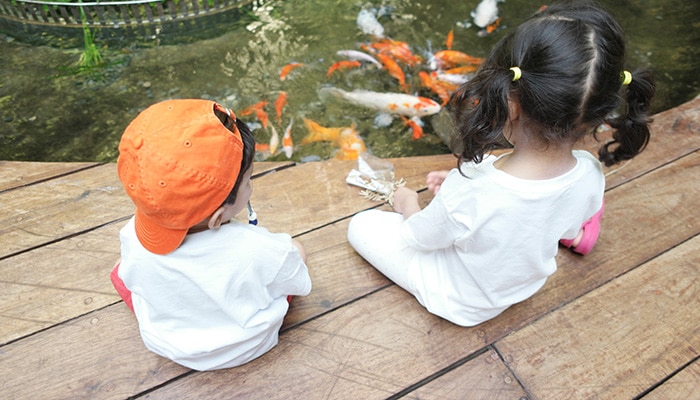While we believe that the books and resources recommended may be of value to you, keep in mind that these are suggestions only and you must do your own due diligence to determine whether the materials are appropriate and suitable for your use. PNC has no sponsorship or endorsement agreement with the authors or publishers of the materials listed.
ANIMAL FRIENDS

Pond Animals
Children will explore the movement of animals that live in ponds.

Lesson Objective
Children will explore and compare the movements of different pond animals.
Art
What You'll Need
- Large floor space
- Scarves – 1 per child
- Drum
- Tambourine
- Book, In the Small, Small Pond by Denise Fleming
- Music selection (see Lesson Tips)
- Audio device for playing music
What To Do
- Discuss what a pond is and the kinds of animals that might live in or around a pond (see Guiding Student Inquiry).
- Read the story, In the Small, Small Pond.
- Review some of the animals from the story and the ways that they move. For example, tadpoles wriggle, minnows scatter, geese waddle, swallows swoop, and so on.
- Tell the children that they will be rereading and enjoying the story by acting it out through movement.
- Perform the steps of the Warm-Up (see Lesson Tips).
- Reread the story, noting the verbs describing the animals’ movement, and lead the children in matching the movements. For example:
- Wiggle, jiggle, tadpoles wiggle – have children wiggle different body parts in their self-space, circle around with a jiggle, wriggle slowly, and then wriggle fast.
- Waddle, wade, geese parade – children line up behind the teacher, who leads the children in waddling while parading around the dance space.
- Hover, shiver, wings quiver – have the children state how they think dragonflies’ wings move. Play the drum and tambourine to signal the speed of the movement, using the drum for a slow beat and the tambourine for faster movements.
- Discuss and compare the various animals’ movements (see Guiding Student Inquiry).
- Wrap up the session with some Cool-Down movements. These can be any kind of slow, calming movements (see Lesson Tips).
Resources
Home School Resources
Home educators: use these printable lesson PDFs to teach this lesson to your home schoolers. They're available in English and Spanish.
Content Provided By
Common Core State Standards Initiative – These lessons are aligned with the Common Core State Standards ("CCSS"). The CCSS provide a consistent, clear understanding of the concepts and skills children are expected to learn and guide teachers to provide their students with opportunities to gain these important skills and foundational knowledge [1]. Visit the CCSS


